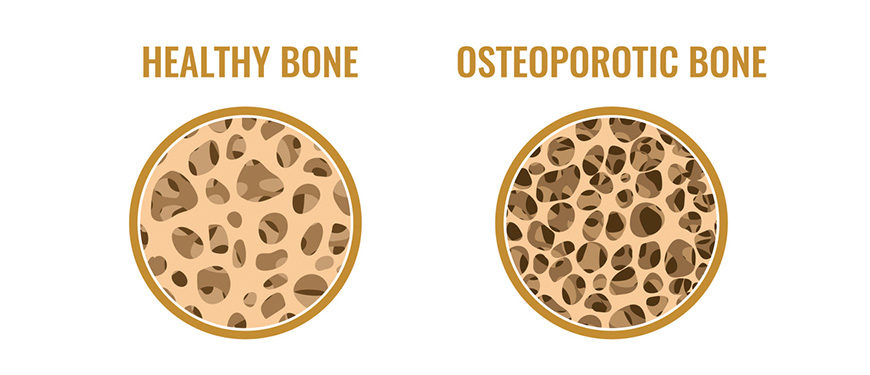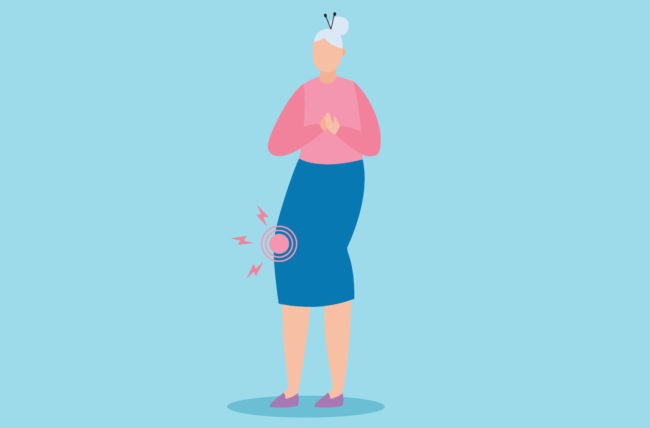How Does Vitamin D Counteract Osteoporosis?
Houston Endocrine Center2022-09-28T14:44:40+00:00We all know that our bones are not as strong when we reach old age, but a lack of calcium is not the only reason for osteoporosis. The human body needs vitamin D to build bones.
As more people become aware of the importance of vitamin D in our body, it is no surprise there are more websites popping up all over the internet advertising a quick fix to use for bone pain or osteoporosis.

Source: Rozelle Medical Center
But how does Vitamin D counteract osteoporosis? How can you get vitamin D naturally? How can your body produce vitamin D on its own?
We are going to answer all of these questions in our blog but before we move forward, let us give you a little introduction to osteoporosis and vitamin D.
What Is Osteoporosis?
Osteoporosis is a disease that causes bones to become thinner and weaker, which makes them more fragile and break easily. People who have osteoporosis are at greater risk of developing fractures, especially those that occur in the hip, spine, or wrist.
The condition occurs when too much bone is lost, and too little is made. This makes the bones weak and more likely to break.
Osteoporotic fractures most commonly occur in older people, but some younger people also develop this disease. It affects about 8 million Americans and about 44 million people worldwide. Women are four times more likely than men to develop osteoporosis.

Source: Cadelius
Osteoporosis usually develops slowly over many years, so you may not notice any symptoms until your bones begin to break. If not treated properly, osteoporotic fractures can cause long-term disability or even death.
Osteoporosis is different from osteopenia, which means “less bone” and refers to low bone mass or thickness. People with osteopenia have a lower risk of developing osteoporosis later in life than those with normal bone density readings do; however, they may still be at risk of fractures caused by falls or other accidents.
What Is Vitamin D?
Vitamin D is a fat-soluble vitamin that helps your body absorb calcium. Calcium is an essential mineral that keeps bones and teeth strong and healthy.
Vitamin D affects the health of almost every tissue in the body, from the intestines to the brain. It also boosts the immune system and helps regulate blood pressure, muscle strength, mood, and more.
The sun is the main source of vitamin D for people who live in temperate climates with little or no sunlight exposure. Other sources include foods like fatty fish, dairy products, mushrooms, and fortified cereals.
The two main forms of vitamin D are cholecalciferol (D3) and ergocalciferol (D2). Cholecalciferol is derived from animal sources, while ergocalciferol is extracted from plants. Both forms can be converted into calcidiol (25-hydroxyvitamin D) — the form used in tests for 25-hydroxyvitamin D — in the liver and kidneys. Calcitriol (1,25-dihydroxy vitamin D) is produced by the kidneys after calcidiol binds with a protein called 7-dehydrocholesterol in the skin or intestines.

Source: Health Shots
Vitamin D supplements are also available. These may be beneficial for certain groups of people who have low levels of vitamin D but don’t get enough from food sources or sunlight exposure.
In recent years, research has suggested that low levels of vitamin D may increase your risk of osteoporosis, heart disease, and cancer. The Institute of Medicine established an Adequate Intake (AI) level for adults up to 70 years old at 600 international units (IU) per day based on bone health alone. However, many experts now recommend an AI level twice as high — 1,000 IU per day — to improve overall health.
Why Is Vitamin D Important For You?
Vitamin D plays an important role in many body processes. It helps the body absorb calcium and phosphorus, which are essential for building and maintaining strong bones. Vitamin D also may help prevent osteoporosis, high blood pressure, cancer, and other diseases.
Vitamin D deficiency is linked to a number of health problems, including cancer and diabetes. In fact, some scientists believe that deficiencies could be responsible for up to 1 billion cases of illness worldwide each year.
Vitamin D is naturally present in very few foods, so most people need to get it through their diet or supplements. The National Academy of Sciences recommends that adults and children aged 19-70 take 600 international units (IU) of vitamin D daily. Women who are pregnant or breastfeeding should take at least 800 IU per day.
The best source of vitamin D is sunlight exposure to the skin. The UVB rays in sunlight convert precursors in the skin into vitamin D 3, which then travels through the bloodstream to the liver, where it’s converted into 25-hydroxyvitamin D (25(OH)D), the most commonly measured form of vitamin D in blood tests.

Source: Cloudinary
How Does Vitamin D Counteract Osteoporosis?
Vitamin D is known to be essential for bone health. It acts as a hormone, regulating the amount of calcium and phosphate in the blood. But how does vitamin D counteract osteoporosis?
Vitamin D helps prevent osteoporosis by increasing the amount of calcium absorbed into the bloodstream from dietary sources. It also increases the body’s ability to use calcium efficiently by helping the liver convert vitamin D into its active form, calcitriol, which regulates calcium absorption in the intestine.
Vitamin D deficiency has been linked to low bone mineral density (BMD), which puts you at risk for developing osteoporosis later in life. In addition, studies show that people with low BMD are more likely to have lower levels of vitamin D than those who don’t have low BMD.
Vitamin D deficiency is common in the United States, especially among older adults and those with darker skin. There are a few reasons why vitamin D deficiency rates are so high:
- Older adults are more likely to have low levels of vitamin D because their bodies produce less of it after age 50, according to the National Institutes of Health (NIH).

Source: Health Essentials
- People who live far from the equator (where sunlight is strongest) or live most of the time indoors are also at greater risk for low vitamin D levels.
- In addition, some medications can interfere with vitamin D absorption and metabolism. For example, antacids can reduce their absorption. At the same time, some antibiotics may increase the production of an enzyme that breaks down vitamin D in the body — both of which make it harder for your body to use this nutrient effectively.
In fact, according to the National Osteoporosis Foundation (NOF), most people are deficient in this crucial nutrient. And while most people know they need calcium to build strong bones and prevent osteoporosis, fewer realize that vitamin D plays an equally important role in bone formation and maintenance.
Vitamin D And Bones
Vitamin D plays an important role in the growth and maintenance of healthy bones, teeth, muscles, and immune systems. It is found in very few foods, so most people get it from exposure to sunlight or dietary supplements. Vitamin D deficiency can result in rickets (in children) and osteomalacia (in adults).
Vitamin D is essential for the absorption of calcium in our bodies. Without enough vitamin D, bones can become thin, brittle, and misshapen as a result of weakened bone structure. This makes them more susceptible to fractures.

Source: Your Beauty Craze
In addition to helping bones absorb calcium, vitamin D also plays an important role in immunity by helping white blood cells fight off infections like the flu or colds. Because of this, some doctors recommend taking vitamin D supplements during cold and flu season to boost immunity against these viruses.
Vitamin D also has been shown to help prevent other diseases such as cancer, type 2 diabetes, and multiple sclerosis (MS). In fact, some studies have shown that people who take vitamin D supplements may be less likely to develop MS than those who don’t take them regularly.
How Much Vitamin D Do You Need?
The answer is it depends. The amount of vitamin D you need depends on your age and whether you are pregnant or breastfeeding.
The current recommendation from the Institute of Medicine (IOM) is that most adults and children older than 1 year should get 600 IU of vitamin D per day. For people over age 70, 800 IU per day is recommended, and for breastfed infants, 400 IU per day is needed. Pregnant and breastfeeding women need at least 600 IU per day until they’re weaned, at which point they should increase their intake to 1,000 IU per day.
But the IOM’s recommendation is based on a few assumptions that may not be correct. Here are a few things to consider when determining how much vitamin D you need:
- Your skin color affects how much sun you need to make vitamin D. The darker your skin, the more time you need in the sun to make vitamin D. The I2OM recommendation takes this into account by suggesting higher dosages for people with darker skin tones than those with lighter skin tones.
- You should take supplements if you do not get enough sun exposure or if you live in a northern climate where there isn’t much sunlight during the winter months (or both). If so, then your dose will be higher than 600 IU/day — perhaps closer to 1,000 IU/day.

Source: NBC News
- You might need more vitamin D if you are overweight or obese because extra fat cells store more vitamin D than leaner people do.
However, these amounts have been determined based on minimal levels necessary to prevent rickets in children living in northern regions where sunlight exposure is limited during the winter months. Recent studies suggest that we need higher amounts of vitamin D to counteract osteoporosis and maintain optimal bone health among adults who live at higher latitudes or who spend less time outdoors than those who live closer to the equator, where sunlight exposure increases throughout the year.
How Does Your Body Produce Vitamin D On Its Own?
Vitamin D comes from three sources:
- Sunlight exposure
- Foods that contain vitamin D
- Supplements
The main source of vitamin D is sunlight exposure. In adults, the body can produce up to 10,000 international units (IUs) of vitamin D per day through exposure to sunlight. It is also found in fish, eggs, fortified milk, and other foods. However, most people in the US do not get enough of it from diet alone.

Source: CTFassets
Vitamin D can be produced by your body when you are exposed to sunlight. The ultraviolet rays from sunlight hit the skin and convert cholesterol into Vitamin D3. The liver converts a different form of cholesterol into 25-hydroxycholecalciferol, or 25(OH)D3. The 25(OH)D3 is then transported through the bloodstream to the kidneys, where it gets converted into 1,25-dihydroxy vitamin D or calcitriol. This form of vitamin D helps us absorb calcium from food and make sure our bones are healthy.
Vitamin D3 can also be manufactured artificially in a lab setting by exposing 7-dehydrocholesterol to ultraviolet light from a high-pressure mercury lamp or by exposing ergosterol to ultraviolet light from an electron beam lamp.
Symptoms Of Vitamin D Deficiency
The following are some common symptoms of vitamin D deficiency:
- Back pain
- Weak and aching bones
- Infections
- Muscle weakness
- Muscle aches
- Fatigue
- Low mood
- Sleep changes (insomnia)
- Dental problems such as tooth decay or gum disease
- Unexplained weight loss
- Frequent cough and cold
- Dry eyes and mouth
- Pale skin and dark circles
- Loss of appetite
- Constipation
- Dry skin

Source: Nu U Nutrition
In addition to the aforementioned symptoms, vitamin D deficiency can also lead to osteoporosis and osteomalacia. Osteomalacia is a bone disorder resulting in softening of bones and muscle weakness. This condition is caused when there is inadequate vitamin D and calcium in the body.
Vitamin D deficiency can also lead to rickets in children who are still developing their bones and muscles. Rickets causes softening of bones that leads to skeletal deformities such as bowed legs and knocked knees.
Conclusion & Takeaway
Being diagnosed with osteoporosis? There are side effects for you to change your life and pursue the nutrients that naturally occur in food and supplements. As higher levels of vitamin D counteract osteoporosis, among all other nutrients, vitamin D will be a great help to you.
Vitamin D does not directly contribute to the risk of osteoporosis, but it does enhance the absorption of calcium. Once in the body, vitamin D and calcium balance each other out. And when one becomes deficient, this is compensated for by an increase in the other.
If you are suffering from bone degeneration, you might want to consider taking supplements but do not know which supplement is best for you and your body. To solve your queries, endocrinologists at Houston Endocrine Center are always here to serve you. Be it your bones or any hormonal disorder, our healthcare providers take care of all your problems. If you want to consult our endocrinologists about your health issues, feel free to contact us at +1 832-862-3236 or visit our website to book an appointment with us!
